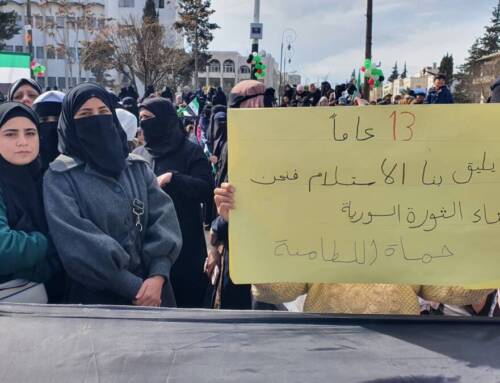Months after coalition-backed victory in Raqqa, bodies still being pulled from the rubble
More than five months after United States-backed Syrian forces captured […]
4 April 2018
More than five months after United States-backed Syrian forces captured Raqqa from the Islamic State, the smell of decaying bodies still rises from piles of rubble that make up most of the city.
Following the scent of decomposition, or reports by local residents, members of the Raqqa Civil Council’s Emergency Team are working their way through the city’s districts on a daily basis to extract and identify the human remains left under piles of shattered concrete.
“We prioritize densely populated districts,” Osama Khalf, a member of the Raqqa Civil Council’s media office tells Syria Direct’s Ghina Ghabreh.
The Raqqa Civil Council was established by the Syrian Democratic Forces (SDF) following the capture of the city in October 2017 to administer local affairs and oversee reconstruction. The council’s Emergency Team, which is responsible for locating, removing and burying bodies, has identified hundreds so far, Khalf says.
Intense bombardment by the United States-led international coalition during the final battle for Raqqa last year left 80 percent of the city in ruins, according to a United Nations estimate.
Thousands of people displaced by initial fighting have returned to Raqqa in recent months to live in the city’s crowded, less-damaged districts. However, fundamental challenges including an ongoing struggle to find and remove human remains persist, complicating reconstruction efforts.
“Our guys are working with basic tools,” says Khalf. “Their work is extremely difficult.”

Q: Are Raqqa Civil Council personnel actively searching for bodies under the rubble, or do you rely on information provided by residents?
There are people on the Emergency Team tasked with searching for destroyed areas that are giving off the smell of decomposing bodies, since it is not enough to rely on residents’ notifications. The work is systematic, and organized on an area-by-area basis. We prioritize densely populated districts.
Q: Are you facing complications regarding the removal of the bodies? How many bodies have you removed so far?
The most significant complication is that we have no heavy machinery. Our guys are working with basic tools, but they still manage to remove the bodies. Their work is extremely difficult.
Abdullah al-Arian [the head of the Raqqa Civil Council’s Reconstruction Committee] requested heavy machinery in multiple meetings with Coalition [personnel], but they did not provide anything.
[Ed.: A United States government official told Syria Direct on Wednesday that the State Department provided the Reconstruction Committee with 21 vehicles for rubble removal. US support for local civilian authorities focuses on “quick impact, short term interventions that are sustainable without ongoing US support,” the official said.]Between February 10 and March 28 of this year, we retrieved approximately 315 bodies.
Q: Do the unrecovered bodies under the rubble pose a risk to returning residents?
The decay of the bodies can spread disease. Insects are significant carriers of diseases, the most widespread of which is Leishmaniasis [a parasitic disease spread by sandfly bites]. The Emergency Team is working very quickly to raise the rubble and extract the bodies before summer comes.
Q: What happens once a body is removed? Do you bury it immediately, or are there any procedures to identify the body? Do you attempt to contact the family of the deceased?
When the residents of the area notify us of a body, [the individual] is usually identified by their clothes or jewelry. Otherwise, forensic experts [can identify them] by their teeth or nails. If nothing is left of the body, then we record the address of where it was found. Each body is registered with a name, number and date of removal, and then transferred to special burial sites. We do not bury the body until it is given an identifying number.

The bodies are not buried immediately. First, we contact those who notified us of the body’s whereabouts, residents of the district or a community leader [to identify the body]. If nobody recognizes it, then we resort to social media, [posting pictures of the bodies] on the pages of the Reconstruction Committee or the Emergency Team.
Q: Where do you bury the bodies?
The bodies are buried in the Cemetery of the Martyrs in the Tal al-Biiah area [approximately three kilometers east of Raqqa city]. It is large and there is room for all of the bodies, but has a symbolic meaning also.
The martyrs of Raqqa [people killed in various wars] have been buried in this cemetery since 1973. There are other cemeteries, but we use this one as a way to honor the innocent civilians who have been martyred in Raqqa.
Q: Has the council faced any complaints from residents about the pace of the removal of bodies or its other operations?
The Raqqa Civil Council’s committees didn’t return to Raqqa until this past December, and it has been only a few months since then. Some 80 percent of the city is destroyed, and the undamaged districts are crowded with residents.
During these three months, most services have been reestablished. Most of the streets are open and undamaged schools are operational—approximately 27 schools for 51,000 students. [Our] municipal, industrial and reconstruction committees are working in the city. We are still working to repair the water grid.
We are not saying that the situation is good. The situation is just okay. No matter what we provide for the city, we will keep falling short, because the country is worn down.







